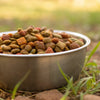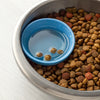How Is Freeze Dried Dog Food Made? Understanding the Process Behind Your Pet's Nutrition
- Houndsy
Table of Contents
- Introduction
- The Science of Freeze-Drying
- The Step-by-Step Process
- Nutritional Benefits
- Safety and Quality Control
- Comparing Freeze-Dried to Other Dog Foods
- Conclusion
Introduction
Have you ever wondered how your dog’s food is made? The journey from farm to bowl is a fascinating process, particularly when it comes to freeze-dried dog food. Did you know that approximately 98% of the moisture is removed from freeze-dried food, retaining the essential nutrients that your furry friend needs? This innovative method not only preserves the natural goodness of raw ingredients but also makes feeding simple and convenient for pet owners like us.
As pet parents, we are constantly seeking the best nutrition for our dogs, balancing quality, convenience, and safety. In this blog post, we will delve into the intricacies of how freeze dried dog food is made, exploring each step of the process while also discussing the benefits and important considerations for pet owners. By the end, you’ll have a clear understanding of why this method is gaining popularity and how it can enhance your dog’s diet.
We will cover:
- The Science of Freeze-Drying: What it is and how it works.
- The Step-by-Step Process: From sourcing ingredients to packaging.
- Nutritional Benefits: Why freeze-dried food is a top choice for many pet owners.
- Safety and Quality Control: How manufacturers ensure your dog’s food is safe and nutritious.
- Comparing Freeze-Dried to Other Dog Foods: Understanding the differences between freeze-dried, kibble, and raw diets.
Let’s embark on this enlightening journey together, reflecting on our own feeding routines and considering how we can elevate our pets' mealtime experiences.
The Science of Freeze-Drying
Freeze-drying is a sophisticated dehydration process designed to preserve food while maintaining its nutritional integrity. Unlike traditional drying methods that utilize heat, freeze-drying employs a unique scientific principle called sublimation.
What is Sublimation?
Sublimation is the process where a substance transitions directly from a solid state to a gas without passing through a liquid phase. In the context of freeze-dried dog food, this means that water is removed from the food without the risk of damaging its cellular structure or depleting essential nutrients. This critical step is what sets freeze-dried food apart from other types of pet food.
Why Freeze-Dry?
The primary purpose of freeze-drying is to extend shelf life while retaining the nutritional value of the ingredients. By removing moisture, freeze-dried food minimizes the risk of bacterial growth and spoilage. This results in a product that is not only safe but also rich in nutrients, vitamins, and minerals, making it an excellent choice for pet owners who prioritize their dog's health.
The Step-by-Step Process
Now that we understand the science behind freeze-drying, let’s take a closer look at the step-by-step process of how freeze dried dog food is made.
Step 1: Sourcing High-Quality Ingredients
The journey begins with the careful selection of ingredients. High-quality proteins, vegetables, and fruits are sourced from trusted suppliers. This ensures that the food is not only nutritious but also free from harmful additives. At Houndsy, we emphasize the importance of quality and integrity, ensuring that our ingredients meet the highest standards for your pet’s health.
Step 2: Flash Freezing
Once the ingredients are selected, they are chopped into appropriate sizes and flash frozen. This rapid freezing process locks in the freshness and preserves the delicate nutrients within the raw ingredients. Flash freezing prevents the formation of large ice crystals that could damage the food’s cellular structure.
Step 3: The Vacuum Chamber
After the ingredients are frozen, they are placed in a specialized vacuum chamber. Here, the pressure is significantly reduced, creating an environment conducive to sublimation. In this low-pressure environment, the frozen water within the food transitions directly from ice to vapor, effectively removing moisture without using heat.
Step 4: Sublimation
During sublimation, the ice crystals transform into vapor, which is then extracted from the chamber. This process ensures that the food retains its texture, flavor, and nutritional value. It’s essential for maintaining the original goodness of the ingredients, making freeze-dried food a premium choice for dog owners.
Step 5: Secondary Drying
Even after sublimation, some water molecules may remain within the food. To ensure complete dryness, a secondary drying process called adsorption occurs. This step breaks the molecular bonds of any remaining water, guaranteeing that the food is entirely moisture-free, which is crucial for long-term preservation.
Step 6: Packaging
Once the freeze-drying process is complete, the food is carefully sealed in moisture- and oxygen-proof packaging. This airtight seal protects the food from environmental factors that could compromise its quality. Proper packaging is vital for ensuring a long shelf life, allowing pet owners to store the food at room temperature without worry.
Nutritional Benefits
The freeze-drying process offers numerous nutritional benefits that make it an attractive option for dog owners. Here are some key advantages:
Retained Nutritional Value
Freeze-drying preserves up to 98% of the original nutrients found in raw ingredients. This means your dog receives a meal packed with essential vitamins, minerals, and proteins, supporting their overall health and well-being.
Convenience
One of the standout features of freeze-dried dog food is its convenience. It requires no refrigeration and can be easily stored at room temperature. This makes it ideal for busy pet owners or those who travel frequently. With freeze-dried food, feeding time becomes a hassle-free experience.
Versatility
Freeze-dried dog food can be served in various ways. It can be given as-is, crumbled over regular kibble, or rehydrated with water or broth for a nutritious meal. This versatility caters to picky eaters and allows for creative feeding options.
Freshness Without the Risk
By choosing freeze-dried food, we can offer our dogs the benefits of a raw diet without the associated risks. The freeze-drying process eliminates bacteria and pathogens, making it a safe alternative to fresh raw food.
Safety and Quality Control
When it comes to our pets, safety is non-negotiable. High-quality freeze-dried dog food manufacturers implement rigorous safety and quality control measures to ensure that their products are safe for consumption.
High-Pressure Processing (HPP)
To further enhance safety, many manufacturers use a process called high-pressure processing (HPP). This technique applies intense pressure to inactivate harmful pathogens in the food without using heat, which could compromise the nutritional value. HPP serves as an additional safety net, ensuring that the food is safe for your dog.
Independent Testing
Reputable manufacturers conduct independent testing of their products to confirm they are free from pathogenic bacteria. This involves sending samples to third-party laboratories for analysis. Only after receiving negative test results does the food leave the facility, providing pet owners with peace of mind.
Transparency and Traceability
Many companies prioritize transparency, allowing pet owners to trace the origins of their dog food. This means knowing where the ingredients come from and how they are processed, which builds trust and confidence in the product we choose for our furry companions.
Comparing Freeze-Dried to Other Dog Foods
In the world of dog food, freeze-dried options stand out when compared to traditional kibble and raw diets. Let’s break down the differences.
Freeze-Dried vs. Kibble
- Processing: Kibble is made using high-heat extrusion, which can degrade heat-sensitive nutrients. In contrast, freeze-dried food retains the majority of its nutrients since it doesn’t involve heat in its preservation process.
- Moisture Content: Kibble contains higher moisture levels, which can lead to spoilage if not stored properly. Freeze-dried food has minimal moisture, ensuring a longer shelf life without artificial preservatives.
- Nutritional Integrity: Freeze-dried food maintains the nutritional integrity of the raw ingredients, offering a more complete and balanced diet for dogs.
Freeze-Dried vs. Raw Diets
- Convenience: While raw diets require careful handling and preparation to avoid bacterial contamination, freeze-dried food provides a safe, convenient alternative that retains the benefits of raw nutrition.
- Storage: Raw diets typically require freezing or refrigeration, whereas freeze-dried food can be stored at room temperature, making it easier for pet owners to manage.
- Safety: Freeze-dried food minimizes the risk of pathogens through the freeze-drying and HPP processes, providing a safer option compared to raw diets that may carry risks if not handled properly.
Conclusion
Understanding how freeze-dried dog food is made can help us make informed decisions about our pets’ nutrition. This innovative method preserves the nutritional integrity of raw ingredients while offering convenience and safety that traditional methods often lack.
As pet owners, we have the responsibility to provide our dogs with the best possible nutrition, and freeze-dried food stands out as a viable option. By embracing this modern approach, we can elevate our pets' mealtime experience, ensuring they receive the nutrients they need to thrive.
If you're considering a change in your dog's diet, we encourage you to explore the benefits of freeze-dried food. Discover how the Houndsy Kibble Dispenser can enhance your feeding routine by offering perfect portions every time, all while maintaining a beautiful aesthetic that complements your home decor. Order now and experience the difference for yourself!
Frequently Asked Questions
What is freeze-dried dog food?
Freeze-dried dog food is a type of pet food that has undergone a preservation process involving freezing and then removing moisture through sublimation. This method retains the nutritional value of the raw ingredients, making it a convenient and healthy choice for pet owners.
How do I rehydrate freeze-dried dog food?
To rehydrate freeze-dried dog food, simply add warm or cool water (never hot) according to the recommended food-to-water ratio, typically around 1:2. Allow the food to sit for a few minutes until it reaches the desired consistency.
Is freeze-dried dog food safe?
Yes, freeze-dried dog food is safe for dogs as long as it is produced by reputable manufacturers who follow strict safety and quality control measures, including high-pressure processing and independent testing.
How should I store freeze-dried dog food?
Freeze-dried dog food can be stored at room temperature in a cool, dry place. Ensure that the packaging is sealed tightly to prevent moisture from entering.
Can I use freeze-dried dog food as a meal topper?
Absolutely! Freeze-dried dog food can be used as a meal topper, adding variety and nutrition to your dog’s regular kibble, enhancing their mealtime experience.












